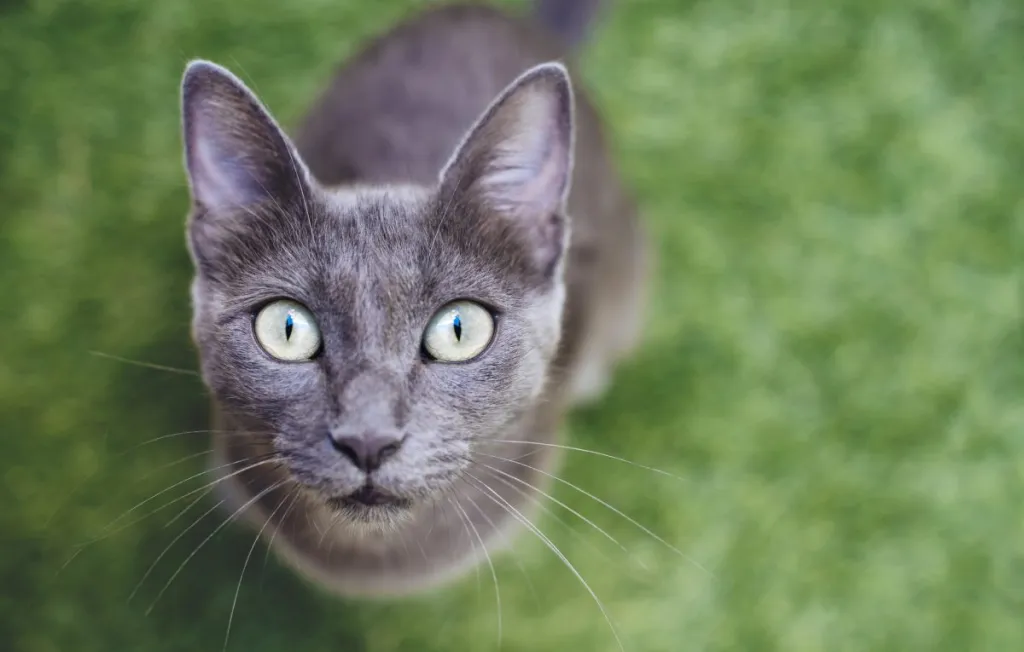The Russian Blue’s elegant yet muscular body led one cat judge to declare him the “Doberman Pinscher of cats.” With their striking appearance and enchanting personalities, these cats have captured the hearts of cat lovers worldwide. These alluring felines have an elegant, silvery-blue coat, bright green eyes, and gentle nature. Interestingly, they are one of the oldest known breeds, with a history that dates back to the 19th century. Originally bred in the Archangel Isles of Northern Russia, they were first brought to England in the late 1800s. These cats were also popular with the Russian Tsars, and they were often given as gifts to foreign dignitaries.
Beyond their bold appearance and storied history, Russian Blues are known for their sweet and loving nature. These kitties are also highly intelligent. Don’t be surprised if they steer clear of the action and any social gatherings at first. They like to assess situations before getting involved. As a result, they can be shy around strangers. Still, they form deep bonds with their human families. These cats thrive on companionship, and their gentle nature makes them excellent pets for families, singles, and seniors alike.
When considering a Russian Blue, it’s advisable to prioritize adopting from rescue organizations or shelters to provide a loving home to a cat in need. However, if you decide to purchase a Russian Blue kitten, it’s crucial to choose a reputable breeder. Conduct thorough research to ensure that the breeder follows ethical practices and prioritizes the well-being of their cats. Reputable Russian Blue breeders prioritize the health and temperament of their cats, conduct necessary health screenings, and provide a nurturing environment for the kitties. This active approach ensures that you bring home a healthy and happy kitty while discouraging unethical breeding practices.
Quick Facts
- Appearance: Russian Blue cats are medium-sized cats with a slender build and long, fine-boned legs. They have a wedge-shaped head with large, triangular ears and almond-shaped eyes that are typically bright green. Their coat is short and dense, with a double layer that helps to protect them from the cold. The coat color can range from a light silver to a deep slate blue, with a silvery sheen.
- Personality: These cats are intelligent, curious, and affectionate. They are also relatively shy at first, but they warm up to people quickly once they feel comfortable. They are typically one-person cats, meaning that they form a close bond with their primary owner. They are also relatively low-maintenance cats, requiring only weekly brushing and occasional bathing.
- Health: Although generally healthy cats, Russian Blues are prone to a few health conditions, like hypertrophic cardiomyopathy (HCM), patellar luxation, and progressive retinal atrophy (PRA). It is important to have your Russian Blue cat looked at for these conditions by a veterinarian.
- In the 2001 movie “Cats & Dogs“, Glenn Ficarra voices Dimitri Kennelkoff, a Russian Blue cat agent, who goes to set off a bomb at Professor Brody’s lab.
Russian Blue Pictures
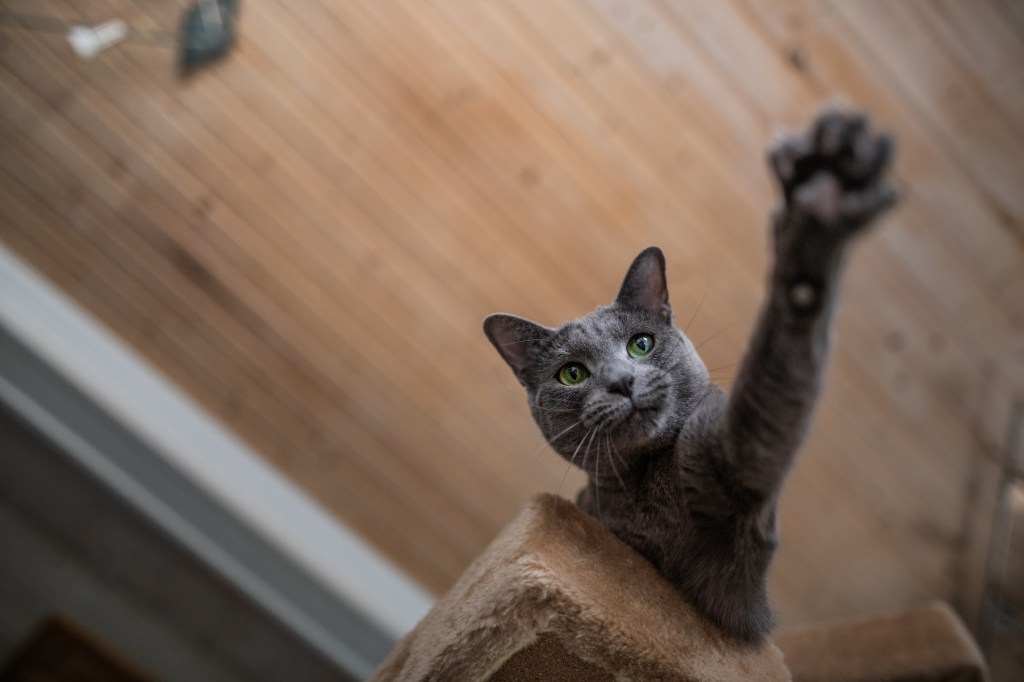
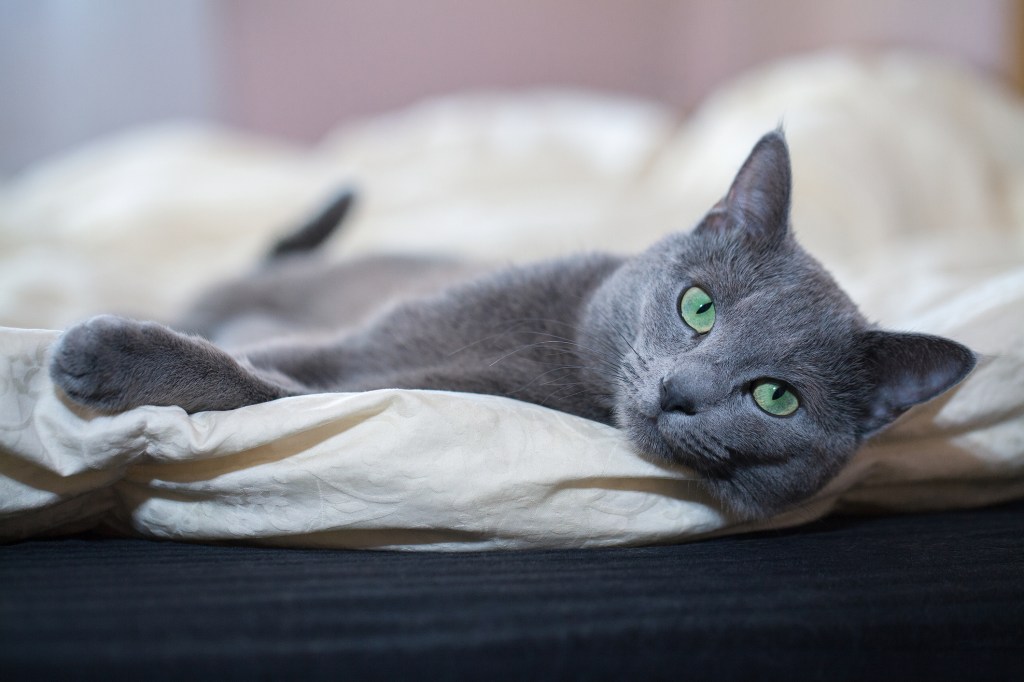

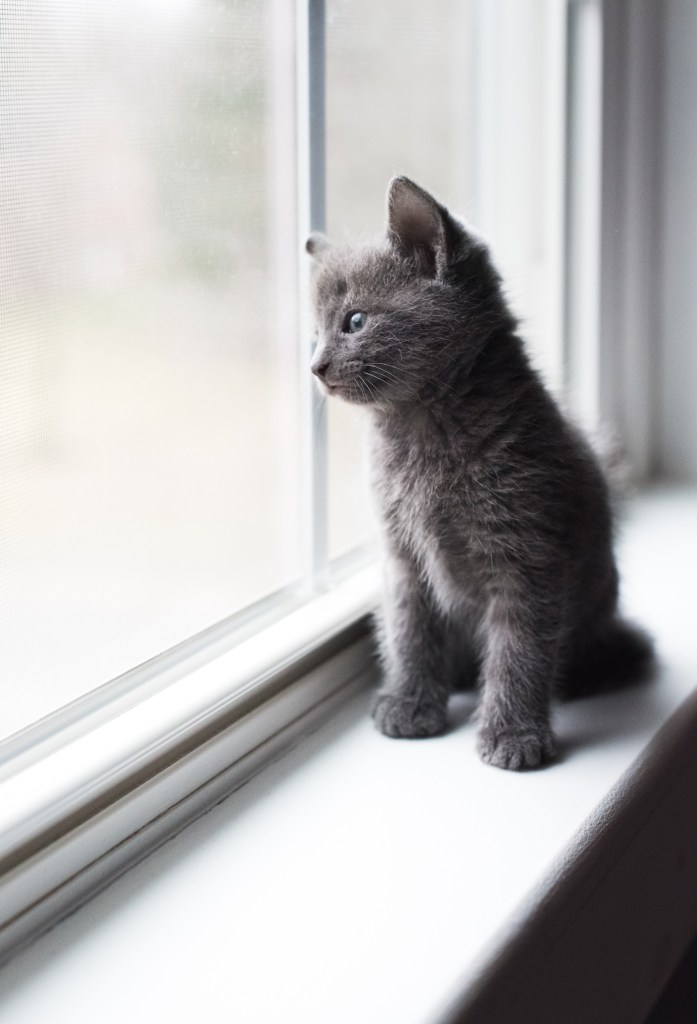
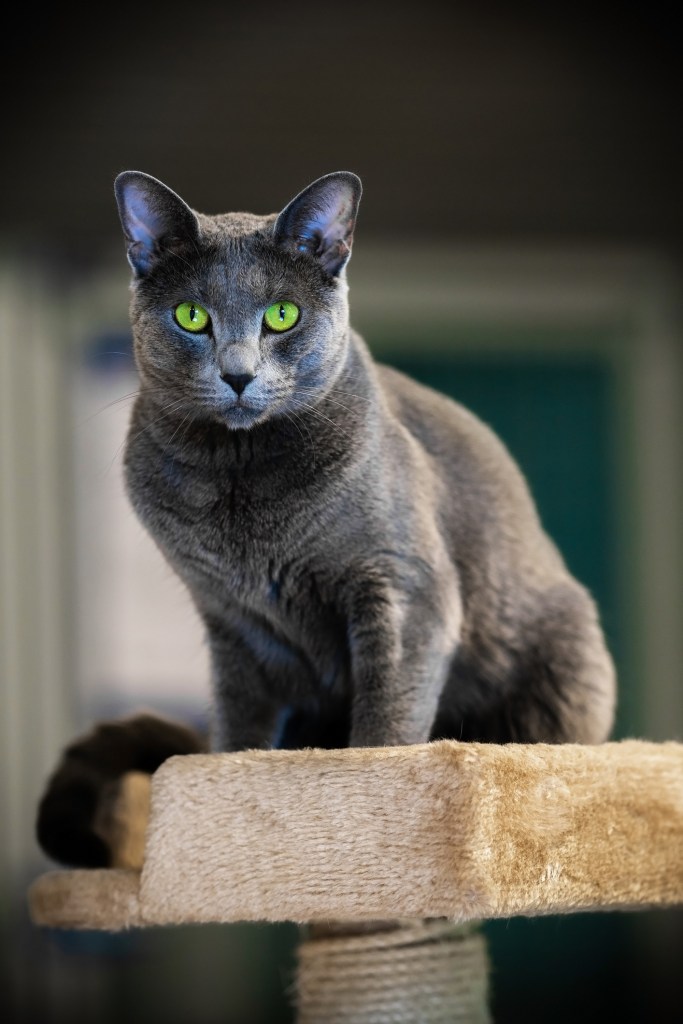

-
Affectionate with Family
Some cat breeds are typically independent and aloof, even if they’ve been raised by the same person since kittenhood; others bond closely to one person and are indifferent to everyone else; and some shower the whole family with affection. Breed isn’t the only factor that goes into affection levels; cats who were raised inside a home with people around feel more comfortable with humans and bond more easily.

See Cats Less Affectionate with Family -
Amount of Shedding
If you’re going to share your home with a cat, you’ll need to deal with some level of cat hair on your clothes and in your house. However, shedding does vary among the breeds. If you’re a neatnik, you’ll need to either pick a low-shedding breed or relax your standards. This furniture cover can make it easier to clean up cat hair and keep it off your sofa!
-
General Health
Due to poor breeding practices, some breeds are prone to certain genetic health problems. This doesn’t mean that every cat of that breed will develop those diseases; it just means that they’re at an increased risk. If you’re looking only for purebred cats or kittens, it’s a good idea to find out which genetic illnesses are common to the breed you’re interested in.
-
Potential for Playfulness
Some cats are perpetual kittens—full of energy and mischief—while others are more serious and sedate. Although a playful kitten sounds endearing, consider how many games of chase the mouse-toy you want to play each day, and whether you have kids or other animals who can stand in as playmates. A classic wand cat toy like this one is perfect for playful felines!
-
Kid-Friendly
Being tolerant of children, sturdy enough to handle the heavy-handed pets and hugs they can dish out, and having a nonchalant attitude toward running, screaming youngsters are all traits that make a kid-friendly cat. Our ratings are generalizations, and they’re not a guarantee of how any breed or individual cat will behave; cats from any breed can be good with children based on their past experiences and personality.
-
Friendly Toward Strangers
Stranger-friendly cats will greet guests with a curious glance or a playful approach; others are shy or indifferent, perhaps even hiding under furniture or skedaddling to another room. However, no matter what the breed, a cat who was exposed to lots of different types, ages, sizes, and shapes of people as a kitten will respond better to strangers as an adult.
-
Easy to Groom
Some breeds require very little in the way of grooming; others require regular brushing to stay clean and healthy. Consider whether you have the time and patience for a cat who needs daily brushing. You should definitely pick up this awesome de-shedding tool for cats of any hair length!
-
Intelligence
Some cat breeds are reputed to be smarter than others. But all cats, if deprived the mental stimulation they need, will make their own busy work. Interactive cat toys are a good way to give a cat a brain workout and keep them out of mischief. This scratcher cat toy can keep your smart kitty busy even when you’re not home!
-
Pet Friendly
Friendliness toward other household animals and friendliness toward humans are two completely different things. Some cats are more likely than others to be accepting of other pets in the home.
Russian Blue History
As with so many cat breeds, little is known of the Russian Blue’s origins. He probably does come from Russia—his thick coat is surely that of a cat from colder climes—and he is considered a natural breed, meaning Matushka Nature created him, not the handiwork of humans.
The Russian Blue’s development as a breed, however, took place primarily in Britain and Scandinavia, starting in the late nineteenth century, when showing and breeding cats became a popular activity. The Russian Blue made his first appearance on the world stage of the cat fancy at an exhibit of cats held at London’s Crystal Palace in 1875.
Labeled an Archangel Cat, because he was said to be from the Russian island of Archangel, he competed against other blue cats of varying types. A newspaper report of the show described the Russian Blue as “very handsome” and “particularly furry,” adding “They resemble mostly the common wild grey rabbit.” Other early names by which the breed was known were Maltese and Foreign Blue.
A British cat fancier named Mrs. Carew-Cox began importing the cats in 1890 and bred and showed them through the turn of the century. She described them as having short, silvery fur, large ears, wide-set eyes and lean faces, with sweet, intelligent personalities—in short, much the same as the Russian Blue of today.
In 1912, the cats were well enough established that they could be shown in a class of their own instead of being lumped together with other blue cats. World War II nearly put an end to the breed. Very few cats survived the years of privation, and British and Scandinavian breeders turned to other breeds, primarily the Siamese and the British Blue, to help revive their bloodlines.
Because of the Siamese influence, the cats developed a more extreme look, and the texture of their coat changed. It took years to bring the breed back to its original appearance. That was achieved by combining British bloodlines, which emphasized plush, silvery coats, and Scandinavian bloodlines, which were known for producing cats with bright breen eyes and flat profiles. The result was the Russian Blue of moderate type seen today.
Russian Blues were first imported to the United States in 1900, but it wasn’t until after World War II that American breeders began to develop their own lines from cats imported in 1947. Today they are popular show cats as well as companions to those who know the secret of their sweet beauty.
Russian Blue Size
Russian Blue cats are generally considered a medium-sized breed with a slim and elegant build. Russian Blue cats typically weigh between 7 to 15 pounds (3.2 to 6.8 kilograms). Males are often larger and heavier than females, but there can be variations within the breed. They have a slender and graceful body with fine bones and well-defined muscles. Their bodies are not bulky, and their frame is sleek and streamlined.
Russian Blues are of average height for a domestic cat breed. They usually stand about 9 to 10 inches (23 to 25 centimeters) tall at the shoulder. They have a long, slender tail that tapers to a fine point. The tail complements their overall elegant appearance.
Russian Blues may appear slightly larger due to their luxurious, plush fur, but underneath the coat, their bodies are relatively compact. It’s important to note that individual Russian Blue cats can vary in size, just like any other breed.
Russian Blue Personality
The Russian Blue has a reputation as a gentle, quiet cat, somewhat shy, but don’t get the wrong idea. This cat may have a reserved nature, but he loves to play (being especially fond of retrieving) and enjoys jumping or climbing to high places where he can study people and situations at his leisure before making up his mind about whether he wants to get involved.
Guests will not receive his immediate attention and may never see him unless he decides they are worthy of his notice, but toward family members, especially his favored person, he is ever loyal, following them through the house and even riding on a shoulder. The Russian Blue is a sensitive cat who doesn’t like to be ignored and will be hurt if he doesn’t receive the same amount of affection he gives. Lack of attention can cause him to become anxious or fearful.
While the Russian Blue loves your company, he is capable of entertaining himself during the day while you are at work. Unlike some active, intelligent breeds, he is not destructive but moves through the house with the lithe grace of a Russian ballerina. When you are at home, his subtle sense of humor and manual dexterity will never fail to entertain. Just make sure you laugh with him, not at him. He has a strong sense of self-worth and doesn’t like being made fun of.
This is a cat who does best in a quiet, stable environment. He doesn’t like change, and it’s especially important to him that meals arrive on time. Count on him to be a faithful alarm clock in the morning, not so you don’t miss work but so he doesn’t miss a meal. If you take the time to develop a relationship with a Russian Blue, your reward will be a deep bond with this loving cat.
Russian Blue Health
Russian Blue cats are generally a healthy breed, but like all cat breeds, they can be prone to certain health issues. It’s important to note that not all Russian Blues will develop these problems, and many can live long, healthy lives with proper care. Here are some health issues that Russian Blue cats may be predisposed to:
-
Hypertrophic Cardiomyopathy (HCM): HCM is a common heart condition in cats, including Russian Blues. It involves the thickening of the heart muscles, which can affect the heart’s ability to function properly. Regular veterinary check-ups and echocardiograms can help detect and manage HCM.
-
Respiratory Infections: Russian Blues may be more susceptible to upper respiratory infections, such as feline herpesvirus (FHV) and feline calicivirus (FCV). These infections can cause symptoms like sneezing, coughing, and eye discharge.
-
Urinary Tract Issues: Russian Blues may be at a slightly higher risk of urinary tract issues like urinary tract infections (UTIs) or urinary crystals. Ensuring they have access to fresh water and feeding them a balanced diet can help reduce the risk.
-
Obesity: Obesity can be a concern for Russian Blues, as they enjoy eating and may become overweight if their diet is not controlled. Maintaining a healthy weight through proper portion control and exercise is essential.
Russian Blue Care
The Russian Blue’s dense coat should be combed twice a week to remove dead hair and distribute skin oils. Brush the teeth to prevent periodontal disease. Daily dental hygiene is best, but weekly brushing is better than nothing. Trim the nails every couple of weeks. A bath when the cat is shedding will help to remove excess hair more quickly. Keep the Russian Blue’s litter box spotlessly clean. He is very particular about bathroom hygiene. It’s a good idea to keep a Russian Blue as an indoor-only cat to protect him from diseases spread by other cats, attacks by dogs or coyotes, and the other dangers that face cats who go outdoors, such as being hit by a car. Russian Blues who go outdoors also run the risk of being stolen by someone who would like to have such a beautiful cat without paying for it.
Russian Blue Coat Color And Grooming
The Russian Blue’s elegant yet muscular body led one cat judge to proclaim him the “Doberman Pinscher of cats.” He has what’s called a semi-foreign body type, meaning it is moderate in shape, falling somewhere between the short, compact body of breeds such as Persians and the sleek angles of Oriental breeds such as the Siamese.
The Cat Fanciers Association breed standard for the Russian Blue calls for him to have a head that is a smooth, medium-size wedge shape with a blunt muzzle. The broad wedge of the head and its flat skull are often described as cobra-like, although that is much too dangerous a description for this sweet-natured cat. Regal is perhaps a better term.
Large ears are wide at the base with pointed tips, the interior lined with thin, translucent skin, and rounded vivid green eyes are set wide apart. A long, slender neck segues into high shoulder blades and a fine-boned body that is firm and muscular, covered with a short, thick double coat with a plush texture, often described as similar to that of a seal or beaver. If you were to run your fingers through a Russian Blue’s coat, the patterns they made would remain until they were petted smooth.
The body is supported by long, fine-boned legs set on small, slightly rounded paws with pads that are a pinky lavender or mauve shade. The tail is long but in proportion to the body. The Russian Blue stands out for his coat color. To the uninformed, he might look gray, but in cat show terms he is an even, bright blue with silver-tipped hairs that make him seem to glisten.
Some Russian Blue kittens are born with “ghost stripes,” a reminder of the tabby gene that all cats carry, even if it isn’t expressed in their coat, but these generally fade, leaving the cat with the solid blue coat of maturity. You might think that a Russian Blue would only come in blue, and in CFA that is true, but other cat associations have more liberal breed standards. In Australia and New Zealand, the cats are called “Russians” and come in white and black as well as the traditional blue. The American Cat Fanciers Association permits black Russians.
Children And Other Pets
Russian Blues have a tolerant nature toward children who treat them kindly and respectfully. They will even put up with the clumsy pats given by toddlers, as if they recognize that no harm is meant, and if necessary they will walk away or climb out of reach to escape being bonked on the head.
That said, the patient and gentle Russian Blue should always be protected from rough treatment, so always supervise very young children when they want to pet the cat. The Russian Blue is also accepting of other animals, including dogs, as long as they aren’t chased or menaced by them. Introduce pets slowly and in controlled circumstances to ensure that they learn to get along together.
